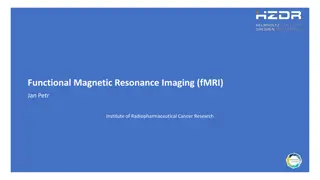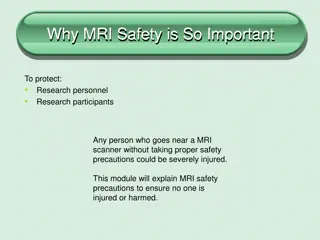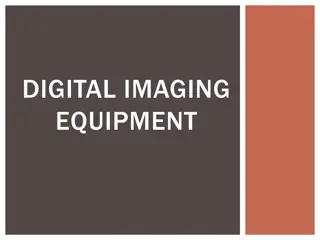MRI BASICS & HISTORY AASIF MAJEED LONE
Magnetic Resonance Imaging (MRI) has revolutionized medical imaging, offering detailed views of the body without harmful radiation. This article delves into the historical development of MRI, highlighting key milestones such as the discoveries of the Rotating Magnetic Field by Nikola Tesla and the work of scientists Felix Bloch and Edward Purcell in the 1940s. The narrative also covers the design of the first MR scanner by Raymond Damadian and the groundbreaking clinical applications of MRI technology. Furthermore, it explores the evolution of MRI techniques for blood flow volume measurements, showcasing the continuous innovation in this vital medical imaging field.
Download Presentation

Please find below an Image/Link to download the presentation.
The content on the website is provided AS IS for your information and personal use only. It may not be sold, licensed, or shared on other websites without obtaining consent from the author.If you encounter any issues during the download, it is possible that the publisher has removed the file from their server.
You are allowed to download the files provided on this website for personal or commercial use, subject to the condition that they are used lawfully. All files are the property of their respective owners.
The content on the website is provided AS IS for your information and personal use only. It may not be sold, licensed, or shared on other websites without obtaining consent from the author.
E N D
Presentation Transcript
MRI BASICS & HISTORY AASIF MAJEED LONE
INTRODUCTION Magnetic resonance imaging is one of the most important imaging modalities in our modern world. It is a non-invasive method for mapping internal structure within the body which uses non-ionizing electromagnetic, radio frequency radiation in the presence of carefully controlled magnetic fields to produce high quality cross-sectional images of the body in any plane. The story of the MRI (Magnetic Resonance Imaging) machine, especially as it is used today for medical purposes, is a tale that weaves together the contributions of many great scientific minds across two generations. It began in 1882 when Nikola Tesla discovered the Rotating Magnetic Field, a fundamental discovery in physics.
HISTORICAL DEVELOPMENT In 1946, two scientists ( Felix Bloch and Edward Purcell ) working independently described a physicochemical phenomenon of the certain nuclei in the periodic table. Their invention is considered to be the start of NMR by many people, and Bloch and Purcell were awarded the Nobel Prize in 1952. Purcell was born in Illinois, USA. After working at Massachusetts Institute of Technology (MIT), he joined Harvard University. Bloch was born in 1905 in Zurich.
Design of the First MR Scanner In 1972, Raymond Damadian (Downstate Medical Centre, Brooklyn) measured the T1 and T2 relaxation times of the normal tissue and tumor in rats and showed that tumors had longer relaxation times using an NMR apparatus. These studies can be considered as the first clinically relevant studies of NMR.
During the 1970s a team led by John Mallard built the first full-body MRI scanner at the University of Aberdeen. On 28 August 1980 they used this machine to obtain the first clinically useful image of a patient's internal tissues using MRI, which identified a primary tumour in the patient's chest, an abnormal liver, and secondary cancer in his bones
Studies on Blood Flow Volume Measurement with MRI Flow measurements with MRI started in 1980s in true sense. However, in 1959, Jay Singer studied the relaxation properties of blood. Later in 1967, Alexander Ganssen , invented an NMR scanner consisting of a number of small coils to measure the blood flow in whole body.
In 1975, he successfully applied Fourier Transformation to image reconstruction. Mansfield was the first to use the fundamental technique that today we call echo planar imaging (EPI). In 1974, Jim Hutchison, Bill Edelstein, and their colleagues from the University of Aberdeen, England, developed the first prototype MR equipment. These scientists imaged a rat by using spin echo technique and in 1980. In 1986, Hennig, A. Nauerth and Hartmut Friedburg together developed quick imaging techniques today known as fast spin echo or turbo spin echo. In 1986, at the same time with Hennig , Haase and Frahm developed and started using the fast gradient echo technique, which is even faster than fast spin echo.
Contrast media that has a great effect on angiographic studies attracted attention in 1980s and became the first company to apply for patent in 1981 for Gd-DTPA. In 1987, EPI technique was used to scan a total phase of heart in real time, and in the same year, Charles Dumoulin succeeded to scan the blood vessels without contrast media by developing the magnetic resonance angiography. In 1993, functional magnetic resonance imaging (f-MRI) technique was developed by using EPI technique. In 1998, FDA (Food and Drug Administration) allowed the marketing of equipments up to 4 T. In 2002, again the same administration allowed the use of 3 T equipments on brain or body.
In 2003, late Paul Lauterbur and Sir Peter Mansfield became the recipient of the Nobel Prize to acknowledge their outstanding contributions to the field of magnetic resonance imaging. Although MRI is most commonly performed in the clinic at 1.5 T, higher fields such as 3 T for clinical imaging and more recently 7 T for research purposes
Special feature of MRI The special feature of MRI includes I. high contrast sensitivity to soft tissues differences, II. inherent safety to the patient (non-ionizing radiation), III.to examine anatomic and physiologic properties of the patient, and IV.imaging of blood flow without contrast.
Advantage Diagnosing: strokes; infections of the brain/spine/CNS; tendonitis. Visualising: Injuries; torn ligaments especially in areas difficult to see like the wrist, ankle or knee . Evaluating: Masses in soft tissue; cysts; bone tumours or disc problems.
MRI is considered ideally suited for soft tissue problems, example:- i. Diagnosing multiple sclerosis (MS) ii. Diagnosing brain tumours iii. Diagnosing spinal infections iv. Visualizing torn ligaments in the wrist, knee and ankle v. Visualizing shoulder injuries vi. Evaluating bone tumours, and herniated discs in the spine vii.Diagnosing strokes in their earliest stages
Some disadvantages of MRI i. Extreme precautions must be taken to keep metallic objects out of the room where the machine is operating . ii. People with pacemakers can't safely be scanned. iii. Some people suffer from confinement discomforting. iv. The machine makes a very loud continuous hammering noise when operating . v. Some people are too big to fit inside the magnet . vi. MRI scans require patients to hold very still for long periods of time ... up to 90 minutes or more in some cases . vii. MRI systems are expensive to buy and run. claustrophobia, and find the
The limitations The limitations includes I. High equipment cost, II. Scan acquisition complexity, III.Long imaging time, IV.Image artifacts , and V. Patient claustrophobia.
Bedside imaging In 2020, the US Food and Drug Administration proffered 510(k) approval of Hyperfine Research's bedside MRI system. The Hyperfine system claimed 20X lower cost, 35X lower power consumption, and 10X lower weight than conventional MRI systems. Hyperfine, a company with offices in New York City and St Guilford, Connecticut, won FDA clearance for the first MRI scanner that can be wheeled to the patient bedside.
Hyperfines Lucy point-of-care MRI is intended for scanning the head, neck, as well as the extremities, in just about any clinical setting. This can be of particular use in emergency rooms, intensive care units, and in facilities that currently don t have access to a conventional clinical MRI. It s not exactly light, weighing in at 1,400 lbs (635 Kg), but it s an order of magnitude lighter than a conventional MRI. A motorized wheel array on the bottom makes it quite manageable to drive the scanner from room to room without actually having to push it manually.
Basic principle of MRI Basic principle of MRI 4 steps Longitudinal and transverse magnetization MR signal and localization of signal. I. Placing the patient in the magnet II. Sending radiofrequency (RF) pulse by coil III.Receiving signals from the patient by coil IV.Transformation of signals into image by complex processing in the computer.
How does protons help in MR Imaging Presently MR imaging is the based on proton. Proton is the positively charged particle present in the nucleus of every atom. Since hydrogen ion has only one particle i.e. Proton. Protons are positively charged and have rotatory motion/ movement called spin. Any charge, which move generates current and every current has a small magnetic field around it. So every spining protons has a small amount of magnetic field.
Without any influence of external magnetic field protons are randomly move in the body in any direction. When external magnetic field applied (patient is placed in the magnet), these randomly moving protons align and spin in the direction of external magnetic field. Some of them parallel and some anti parallel to the external magnetic field. NOTE:- When protons align not only they rotates around themselves but also their axis of rotation moves such that it forms a cone. This movement of protons along-with their cone formation is called precession.
The number of precession of proton per unit time is called precessional frequency, and is measured in Hertz. Precessional frequency is directly proportional to the strength of external magnetic field. Therefore stronger the magnetic field higher precession frequency.
This is expressed by Larmor frequency or Larmor equation:- W0(note) = yB0 where, W0 = precession frequency y = Gyro magnetic ratio, which is specific for particular nucleus. B(note) =Strength of external magnetic field in Tesla. NOTE:- Precession frequency of hydrogen protons for 1 Tesla is 42.57MHz and for 1.5 Tesla is 63.85 MHz
Magnetization Magnetization or magnetic polarization is the density of magnetic dipole moments that are induced in a magnetic material when it is placed near a magnet. The magnetic effects of a material can also be induced by passing an electrical current through the material; the magnetic effect is caused by the motion of electrons in atoms, or the spin of the electrons or the nuclei.
Magnetic moment A magnetic moment is a quantity that represents the magnetic strength and orientation of a magnet or other object that produces a magnetic field. More precisely, a magnetic moment refers to a magnetic dipole moment, the component of magnetic moment that can be represented by a magnetic dipole. A magnetic dipole is a magnetic north pole and a magnetic south pole separated by a small distance.
Magnetism is a property of matter that is a result of the orbiting electrons in atoms. The orbiting electrons cause the atoms to have a magnetic moment associated with an intrinsic angular momentum called spin. Magnetic field strengths are measured in tesla (T), a derived SI unit. The equivalent, and superseded, cgs unit was the gauss (G). One tesla equals 10,000 gauss. The earth's magnetic field is about 25-65 micro-tesla or 0.25- 0.65 Gauss.
Magnetic susceptibility It is the ability of the substance to get affected by external magnetic field and is related to electron configuration of the atom . Depending upon the susceptibility substances can be paramagnetic, diamagnetic or ferromagnetic. Para magnetisms:- The substances having unpaired electrons within the atom. This results into the small magnetic field around them called magnetic moment. When external magnetic field applied these moment add together and align in the direction of external magnetic field. Thus paramagnetic substance effect external magnetic field positive way by attraction towards the field resulting in a local increase in magnetic field Example: Gadolinium, Oxygen , Melanin etc. in
Diamagnetisms The substance react in opposite way when external magnetic field applied . They are repelled by the magnetic field. Thus they have negative magnetic susceptibility and show slight decreases in magnetic field strength . Diamagnetism is the property of materials that have no intrinsic atomic magnetic moment, but when placed in a magnetic field weakly repel the field, resulting in a small negative magnetic susceptibility. Materials like water, copper, nitrogen, barium sulfate, and most tissues are diamagnetic.
Ferromagnetisms Ferromagnetic substances when come in the contact with a magnetic field they get strongly attracted. The magnetic field in these substances is hundred or thousand times more then applied external magnetic field . These materials have a large positive magnetic susceptibility, i.e. when placed in a magnetic field, the field strength is much stronger inside the material than outside. Ferromagnetic materials are also characterized by being made up of clusters of 1017to 1021atoms called magnetic domains, that all have their magnetic moments pointing in the same direction. Example: Iron , Cobalt, Nickel etc.
Magnetic field strength The direction of magnetic flow called Magnetic field strength. Magnetic flux : The number of magnetic lines of forces set up in a magnetic circuit is called Magnetic Flux. It is analogous to electric current I in an electric circuit. Its SI unit is Weber (Wb) and its CGS unit is Maxwell. It is denoted by m. amount of magnetic flux in a unit area perpendicular to the
Magnetic field strength is expressed by B . The primary magnetic field is expressed by secondary magnetic field is as B1. The unit of magnetic field strength are Gause and Tesla. 1Tesla = 10 000 Gauss. B0 and
Longitudinal magnetism Longitudinal magnetisation is the component of the net magnetisation vector parallel to the magnetic field (z- axis). This is due to a difference in the number of spins in parallel (low energy) and anti-parallel (high energy) state i.e. before a radiofrequency pulse.
LM When a patient place into MR moving Hydrogen protons align along the z-axis with positive & negative side. Always more protons align towards positive side as compare to negative side. After alignment the same number of protons cancel out and some amount of protons still remain at positive side, and it form longitudinal magnetization along z-axis. It is a useful protons which take part in MR imaging. Gantry, the random
Transverse magnetisation Transverse magnetisation is the component of the net magnetisation vector perpendicular to the magnetic field (x-y plane). This is due to the spins of individual protons getting more or less into phase i.e. after a radiofrequency pulse. When R/F Pulse sent the reduction of LM to form a new magnetization and these new form is called Transverse magnetization.
Relaxation Relaxation is define as the recovery of excited protons back towards equilibrium after been disturbed by RF pulse. Relaxation time of protons and heterogeneous composition of tissue-protons densities determines the contrast in MR image.
Longitudinal relaxation When RF pulse switch off, protons start losing their energy . This energy is given to surrounding or lattice, so also called spin-lattice relaxation . As protons lose their energy the magnitude of LM increase.
T1 T1 is the time taken by LM to recover after RF pulse is switched off to its original value. This is not exact time but is constant. It is the time when LM reaches back to 63% of its original value. Its depend upon the composition , structure, and surroundings tissue composition.
Transverse Relaxation/Decay It is define as the time taken by TM to reduce to its original value is called transverse relaxation time or T2. Its also known as spin-spin relaxation. Longitudinal relaxation and Transverse relaxation are independent process.
T2 T2 is the time taken by TM to disappear . Like T1 it is the constant but not exact time . Time taken to reduce to 37% of its original value. Its depends upon the inhomogenity of external magnetic field and inhomogenity of local magnetic field within tissue.























